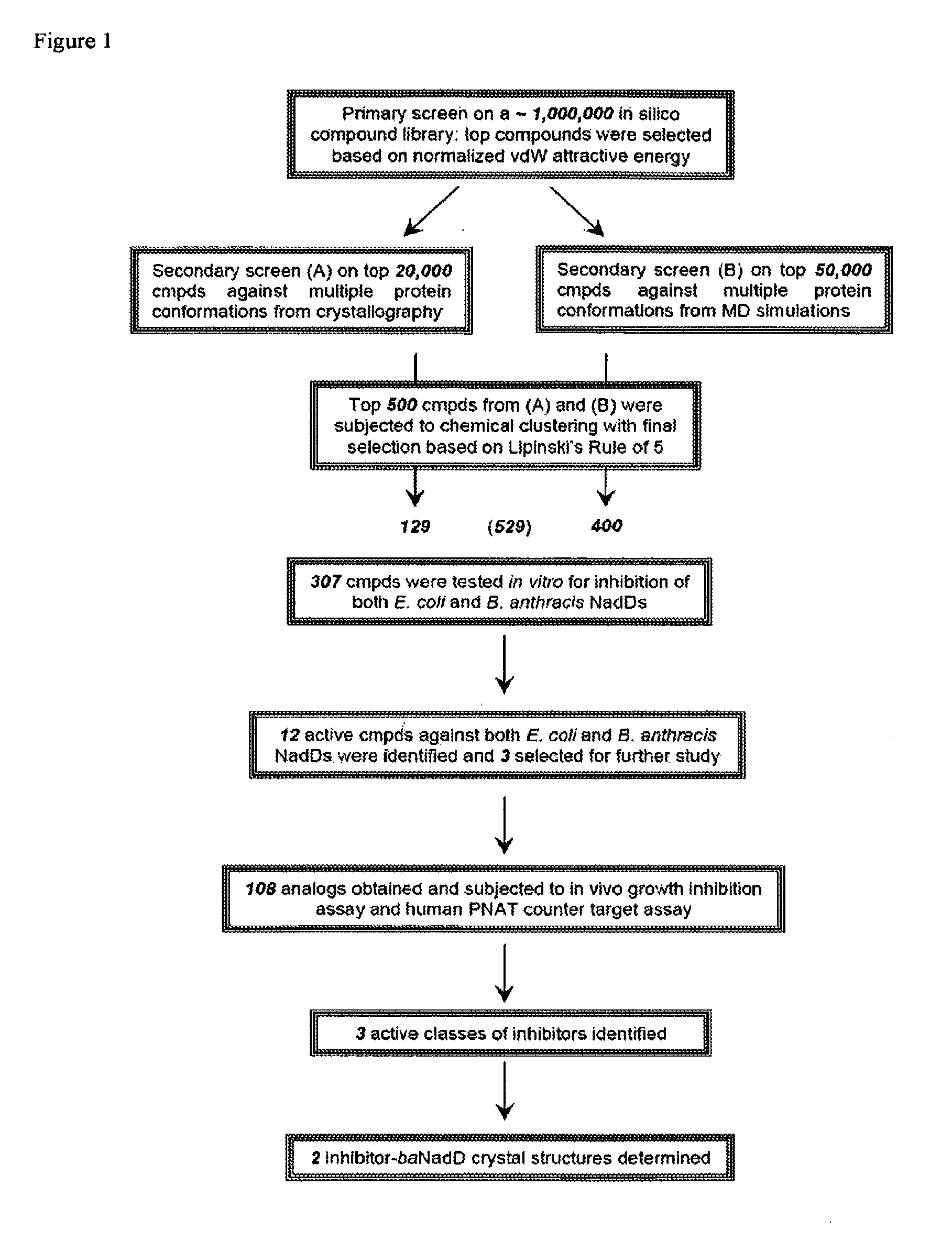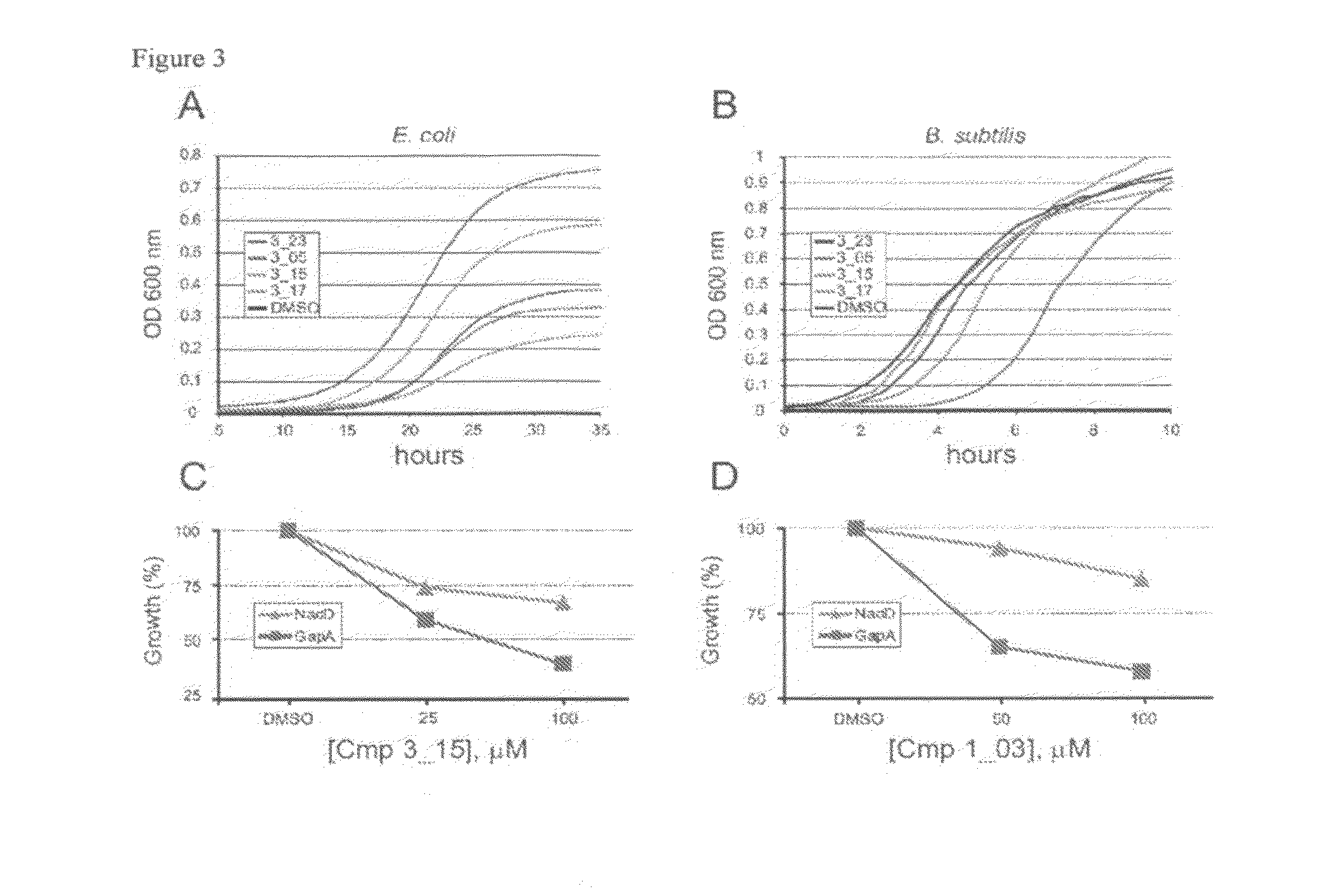Targeting nad biosynthesis in bacterial pathogens
a bacterial pathogen and biosynthesis technology, applied in the field of microorganisms, can solve the problems of further exacerbated need for new targets
- Summary
- Abstract
- Description
- Claims
- Application Information
AI Technical Summary
Benefits of technology
Problems solved by technology
Method used
Image
Examples
example 1
System Preparation for In Silico Database Screening
[0099]The substrate binding site of ecNadD [S1] was selected as the target for docking. Visual inspection of the binding region, solvent accessibility calculations along with consideration of sequence conservation led to the selection of residues Phe8, His19, Ile105 and Ile106 to define the putative inhibitor binding site. In addition, the level of sequence conservation between the bacterial and human enzymes in this region is low, thereby maximizing the potential that inhibitors specific for bacterial NadD are identified. The apo ecNadD structure (pdb 1k4k) was used for the primary screen as it represents a more open form of the binding pocket compared to the product deamido-NAD bound form. Molecular modeling and dynamics calculations were undertaken to prepare the protein structures for screening. All modeling calculations were performed with the program CHARMM [S2, S3] using the CHARMM22 all-atom protein force field and the TIP3P...
example 2
Chemical Similarity and Compounds' Clustering
[0100]Chemical similarity was determined using the MACCS Bit fingerprints in combination with the Tanimoto index to define the level of chemical similarity between two compounds [S8, S9]. This procedure allows for all the compounds to be sorted into clusters where the compounds in each cluster have similar chemical features [S10]. One or two compounds were then selected from each cluster, with the selection being based on physical properties related to Lipinksi's rule of 5 [S11, S12]. Application of these rules during compound selection maximizes the potential that the selected compounds will have appropriate bioavailability properties. However, in cases where clusters did not contain compounds that had all the desired physical properties, compounds were still selected for assay. Chemical clustering and estimation of physical properties was performed using the program MOE (Chemical Computing Group, Inc.).
example 3
In Silico Screening of the Compound Library
[0101]The substrate binding site of ecNadD [19] was selected as the target for docking. System preparation involved analysis of the target protein structure, selection of inhibitor binding site, and generation of the sphere set used to direct the docking. The design of the template for in silico screening was based on the 3D structure of ecNadD reported in our earlier study [19]. The targeted binding pocket encompassed the nicotinosyl binding site (near residues Asn40, Thr85, Phe104 and Ile106 in ecNadD) as well as the catalytic site near the conserved (H / T)×GH motif (around Phe8, Gly10 and His19). All database screening calculations were carried out with DOCK 4.0 [37, 38]. The primary screening was performed on a 3D database of over 1 million low-molecular-weight commercially available compounds developed in the University of Maryland Computer-Aided Drug Design (CADD) Center [39, 40]. Ligand flexibility was incorporated during docking via ...
PUM
| Property | Measurement | Unit |
|---|---|---|
| Current | aaaaa | aaaaa |
| Digital information | aaaaa | aaaaa |
| Volume | aaaaa | aaaaa |
Abstract
Description
Claims
Application Information
 Login to View More
Login to View More - R&D
- Intellectual Property
- Life Sciences
- Materials
- Tech Scout
- Unparalleled Data Quality
- Higher Quality Content
- 60% Fewer Hallucinations
Browse by: Latest US Patents, China's latest patents, Technical Efficacy Thesaurus, Application Domain, Technology Topic, Popular Technical Reports.
© 2025 PatSnap. All rights reserved.Legal|Privacy policy|Modern Slavery Act Transparency Statement|Sitemap|About US| Contact US: help@patsnap.com



